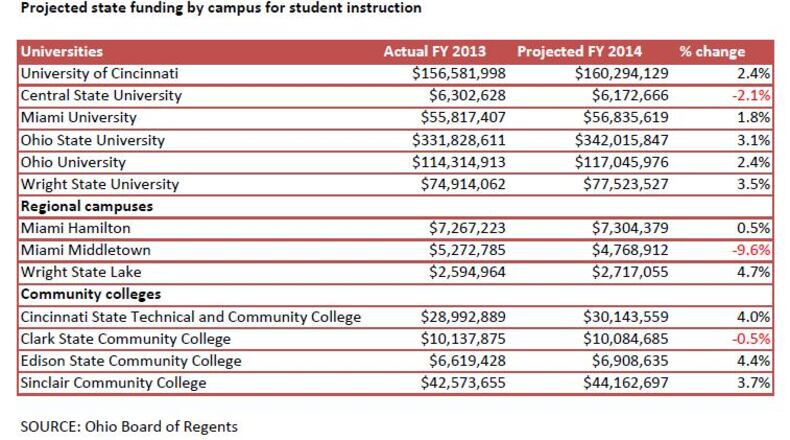The losses come even as Kasich is asking state lawmakers to increase taxpayer dollars that support student instruction by 1.9 percent in both 2014 and 2015. Over the two years, the state would spend $3.6 billion on instruction, if Kasich's budget gets approval from the state legislature. Forty-four campuses will gain funding, including an extra 3.5 percent for Wright State University, 3.1 percent for Ohio State University, 2.4 percent for the University of Cincinnati and 2.4 percent for Ohio University.
“This is just the very beginning of the state budgeting process. We’ve got a long way to go,” said Joe Jackson, vice president for business affairs at Clark State Community College.
Kasich is pushing colleges and universities to graduate more students by tying 50 percent of university funding to whether students earn a degree, and half of community college funding to whether students complete classes and reach other success points. State officials said the redesigned formula, which was recommended by college presidents, pushes Ohio to the forefront nationally for performance-based funding.
At the same time, Kasich seeks to limit how much public colleges and universities can increase tuition each year for in-state undergraduates to either 2 percent over what the institution charged the previous year or 2 percent over the statewide average by sector, whichever is greater.
Together, the initiatives are aimed to improve Ohio’s place as 35th in the nation for degree attainment — a rank that puts the state at a “competitive disadvantage,” said Tim Keen, director of Ohio’s Office of Budget & Management.
“Our success really depends on having a skilled workforce, and that really starts with a quality education,” Keen said. “We want to graduate people and we also want to try to keep college affordable. We need to have people who feel they can afford to go to school, succeed and graduate.”
The budget would increase the special supplement going to Central State by 1.2 percent, bringing it to $11 million in each fiscal year.
‘Take the burden off… students’
Some Ohio college presidents are concerned by the funding level and tuition increase caps, which present challenges for institutions whose budgets rely more than 50 percent on tuition revenue, said Ron Abrams, president of the Ohio Association of Community Colleges. Additional changes for community college funding will be made in the second year of the state budget.
“The better the state funds us, that means the less we have to depend on revenue from student tuition,” Jackson said.
“We need to take the burden off of the students,” he added. “We understand the challenges the students face, especially our students, whose average age is 28 years old. They may support a family. They may be a single head of household. We understand they’re coming to school to better their quality of life.”
Miami Middletown spokesman Perry Richardson said his campus will have discussions on how to address the nearly $504,000 anticipated reduction in state funding. He said the campus anticipates some help in solving it by adding more four-year degrees and creating new articulation agreements to connect with community college students.
While in the past two years, schools were able to increase tuition and general fees as much as 3.5 percent, Jim Lynch, spokesman for the Office of Budget and Management, said the 2 percent cap holds those cost increases to the rate of inflation.
At many universities, a 2 percent increase in tuition would add another $200 per year.
“That’s not a small amount of money for people who are working their way through school,” said Lane Hart, student body president at the University of Cincinnati.
He said it can be especially alarming for students taking on debt to pay for college. The average debt load for Ohio graduates is $28,683, making Ohio a “high debt state,” according to the Project on Student Loan Debt.
“It’s a very serious issue that a lot of people are concerned about, especially in this job market,” said Hart, a Lewisburg native. “Anything we can do to control the cost is good. It all adds up and we need to look at the total cost of education, which includes books, lab fees, these other undergraduate fees and the cost of living on campus.”
Kasich’s proposal does not control the growth of other fees, including those for technology, entertainment and new charges universities have begun to levy on certain majors or classes, such as engineering.
Budget signals importance of higher ed
Some higher education officials saw positive signs in the state budget.
“While other states are reducing funding for higher education, the governor has affirmed the importance of an educated workforce for Ohio’s well-being by providing an increase for a new funding formula,” said Wright State University President David Hopkins.
Sean Creighton, executive director of the Southwestern Ohio Council for Higher Education, said the tuition cap will help address affordability and the budget overall signals a desire to educate more Ohioans. Just 25 percent of people in the state have a bachelor’s degree, which is below the state average, he said.
“The good thing is the message was strong in terms of how important education is,” he said.
About the Author
